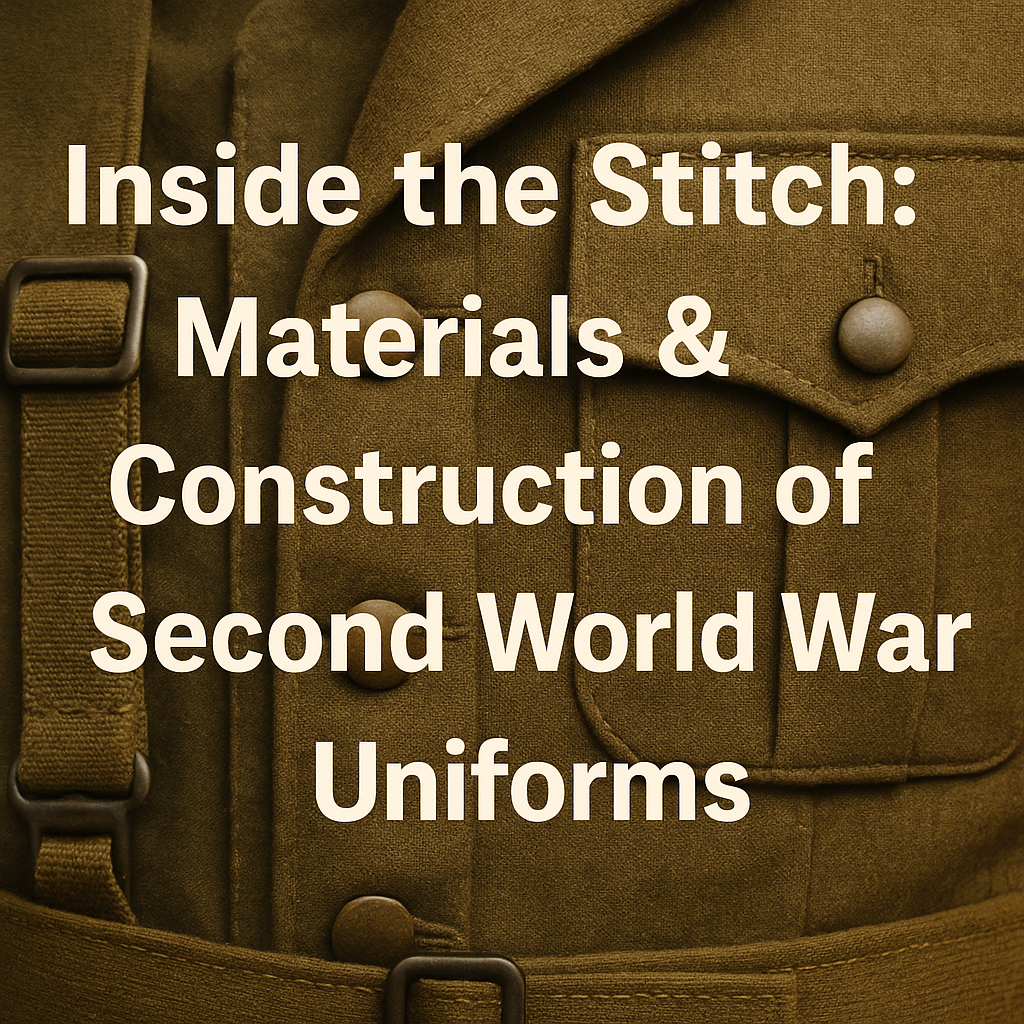
Inside the Stitch: Materials & Construction of Second World War Uniforms”
Published on Apr 20, 2025
Inside the Stitch: Materials & Construction of Second World War Uniforms
introduction
When we think of World War II, we often picture epic battles, iconic leaders, and the sheer scale of global conflict. But one often-overlooked aspect that had a direct impact on morale, performance, and survival was the uniform. The materials and construction of Second World War uniforms played a vital role in the daily lives of millions of soldiers.
In this in-depth guide, we’ll take a look at the fabric choices, stitching methods, and design philosophies behind WW2 and Korean War uniforms—especially how they varied by country. Whether you’re a historian, collector, or enthusiast, this is your front-row seat to the craftsmanship behind the khaki and wool.
Why Uniform Construction Mattered in WW2
Unlike modern warfare, where materials like Kevlar and synthetic blends dominate, WWII uniforms were crafted from natural fibers, tailored with basic but highly durable techniques.
- Function over fashion: Comfort and utility took priority over appearance.
- Environment-driven: Uniforms were adapted for deserts, jungles, winters, and urban warfare.
- Mass production: With millions enlisted, the materials used needed to be accessible and quickly manufactured.
Common Materials Used in Second World War Uniforms
1. Wool
Wool was the most widely used material during WW2, especially by European forces. It was favored for its durability and insulation.
- Pros: Warmth in cold weather, strong, water-resistant to a degree.
- Cons: Heavy when wet, itchy, not ideal for hot climates.
2. Cotton
As the war stretched into tropical zones and summer campaigns, cotton became essential for its breathability.
- Used in: Shirts, tropical uniforms, undergarments.
- Nations: Widely used by the U.S., Britain, and Japan in hot climates.
3. Canvas and HBT (Herringbone Twill)
HBT was particularly common in American gear, valued for its balance of softness and durability.
- Application: Combat jackets, trousers, workwear.
- Advantage: Easy to clean, less rigid than wool.
4. Leather and Rubber
Used more sparingly, these materials featured in accessories such as boots, belts, and sometimes helmet liners.
Uniform Construction: Stitch by Stitch
WW2 uniforms weren't just sewn; they were engineered.
Seam Strength
Heavy-duty stitching was essential. Most uniforms featured double or triple stitched seams, particularly around high-movement areas like shoulders and elbows.
Buttons and Fasteners
- Buttons were usually metal or bakelite early in the war, transitioning to plastic due to shortages.
- Zippers were rare, often avoided because of failure risk under combat stress.
Pockets and Structure
Pockets weren’t just for looks—they were meticulously placed for utility:
- Extra ammunition
- Medical kits
- Rations
Reinforcements
Knee and elbow patches were common in combat uniforms, increasing longevity.
WWII Uniforms by Country: A Global Comparison
Every major power had its own take on uniform design. Here's how materials and construction varied across nations.
United States
Material: Cotton HBT, wool, canvas
Known For: Standardized production, functional field jackets like the M43
Construction Detail: Reinforced stitching, functional pockets, integrated belts
Germany
Material: Wool, gabardine
Known For: Sharp tailoring, distinct camouflage (later war)
Construction Detail: High craftsmanship early in the war, declining quality toward the end
Soviet Union
Material: Coarse wool, cotton
Known For: Simplistic design for mass production
Construction Detail: Straight cuts, minimalistic, very utilitarian
United Kingdom
Material: Heavy wool serge
Known For: The "Battledress" uniform, smart look
Construction Detail: Thick fabric, multiple pockets, quality stitching
Japan
Material: Cotton, wool blends
Known For: Lightweight tropical uniforms, multipurpose design
Construction Detail: Compact fit, climate-adapted materials
Korean War Uniforms: Evolution of WW2 Designs
The Korean War uniforms built upon the WWII foundation, with better materials and updated tailoring.
- Synthetic fibers began to be introduced.
- Layering systems became common (field jackets, liners, wool shirts).
- Design emphasis shifted more toward comfort in extreme climates like Korean winters.
American uniforms in Korea, for instance, used improved M51 field jackets, featuring water-repellent cotton blends.
The Legacy of WWII Uniform Construction Today
Collectors, reenactors, and historians continue to admire the craftsmanship of Second World War uniforms. Modern reproductions often mirror these classic materials, while original pieces are sought after for their historical value and rugged beauty.
At Paddelaters.com, we understand that a uniform is more than just clothing—it’s a piece of history. Our collection of WW2 uniforms, categorized by country, and spanning into the Korean War, preserves the authenticity and detail of wartime tailoring.
Final Thoughts
Understanding the materials and construction of WWII uniforms isn’t just about textiles—it’s about stepping into the boots of those who wore them. Each seam tells a story, and every material choice reflects a strategic decision in one of the most intense periods of world history.
Whether you’re deepening your research, expanding your collection, or just starting to explore this fascinating field, the craftsmanship behind the uniforms is as compelling as the battles they endured.
